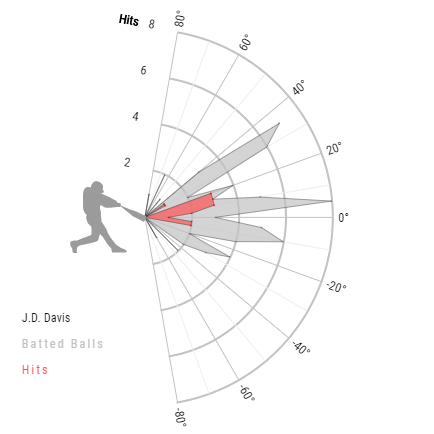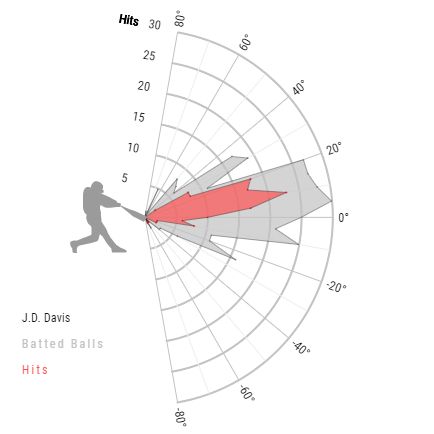What if I told you there was a hitter who finished 2019 in the top 90th percentile in exit velocity, hard hit rate, xBA, xSLG and xwOBA. Must be Mike Trout? No. Ronald Acuna? No. J.D. Davis?!?! Yes, duh. Then, what if I told you he was being drafted after pick 170 in March 2020 drafts. This surely is a mistake. The Statcast numbers must be inaccurate, the ADP is wrong, he is make-believe. False. He is not make-believe, he is J.D. Davis. I am here to tell you why people aren’t fully buying in, but why you need to exploit their oversight.
| Exit Velocity | Hard Hit % | xBA | xwOBA | xSLG | ADP March 2020 | |
|---|---|---|---|---|---|---|
| Mike Trout | 80 | 81 | 98 | 100 | 100 | 1.5 |
| Ronald Acuna | 78 | 89 | 78 | 93 | 94 | 2.2 |
| Christian Yelich | 98 | 96 | 98 | 99 | 99 | 2.6 |
| Cody Bellinger | 80 | 85 | 100 | 100 | 99 | 4.4 |
| Mookie Betts | 84 | 88 | 98 | 97 | 94 | 6.1 |
| J.D. Davis | 90 | 91 | 97 | 92 | 91 | 171.4 |
A quick Statcast explanation: Statcast is a high-speed automated tool developed to analyze player movements. It was officially introduced in all MLB stadiums in 2015. The xABC metrics are the expected batting average, slugging percentage, etc. based on the quality of contact a player makes. While not always indicative of on-field success, the goal is to find the intrinsic value of a player’s skill and remove random variables like luck.
The primary, and warranted, concern for J.D. Davis heading into the season is playing time. Davis split time between left field and third base in 2019, primarily playing in the outfield. Heading into 2020, however, third base is manned by Jeff McNeil. There are three spots in the outfield, but there’s a bit of a log jam when considering Davis, Brandon Nimmo, Michael Conforto, Dom Smith as well as the looming return of Yoenis Cespedes. Nimmo and Conforto are locked into CF and RF respectively and Davis should slide into left to start the year. Dom Smith will ride the bench and fill in at first and in the outfield when players need rest. The Mets will almost certainly play Cespedes upon his return from injury given their massive financial investment. The undetermined opening day date makes it difficult to estimate how the lineup will look. As of today, RosterResource has Davis starting in left and batting fifth in what is a good New York Mets lineup.
People will argue that J.D. is too old to break out, as he was 25 and now 26. Some argue that these out-of-nowhere seasons typically prove to be flukes. I want to illustrate a comparison to fellow Met, Pete Alonso. I recognize the stark contrast here. Alonso was a highly touted prospect who finished his 2019 campaign with a Home Run Derby crown, All-Star appearance and Rookie of the Year trophy. 2019 couldn’t have gone any better for the Polar Bear. What I would like to highlight is that Alonso is 25, which is only a year younger than Davis, and trailed his teammate in the five major Statcast measures I mentioned at the beginning of the article. Below are the 2019 results and statcast measures for the teammates:
| Exit Velocity | Hard Hit % | xBA | xwOBA | xSLG | |
|---|---|---|---|---|---|
| Pete Alonso | 78 | 71 | 43 | 89 | 89 |
| J.D. Davis | 90 | 91 | 97 | 92 | 91 |
I am not making the case that Davis is better than Alonso. That being said, Alonso broke out at age 24 and everyone is buying in. While people should not expect a 2019 repeat, the consensus projections are nearly 45 bombs and around 110 RBI (based on a 162 game season). I acknowledge the historical rookie season, but why is Alonso’s breakout at 24 legit and Davis’ breakout at 25 not? I get Davis was not a top prospect, but these things happen. Nonetheless, J.D. Davis was far from underwhelming in the minors. Drafted in the third round by the Astros in 2014, Davis never posted a wRC+ under 130 at any stop in the minors. Scouts graded the raw power at 70, but doubted the hit tool and in-game power. But did J.D. put it all together last year?
| G | HR | RBI | R | AVG | OBP | |
|---|---|---|---|---|---|---|
| A | 193 | 39 | 153 | 131 | 0.290 | 0.370 |
| AA | 213 | 44 | 141 | 110 | 0.273 | 0.337 |
| AAA | 101 | 22 | 99 | 66 | 0.335 | 0.400 |
Another J.D., (Martinez), broke out in his 26-year-old season in eerily similar fashion.
| Age | PA | HR | R | RBI | SB | AVG | OBP | K% | BB% | |
|---|---|---|---|---|---|---|---|---|---|---|
| J.D. Martinez (2014) | 26 | 480 | 23 | 57 | 76 | 6 | 0.315 | 0.358 | 26.30% | 6.30% |
| J.D Davis (2019) | 25 | 453 | 22 | 65 | 57 | 3 | 0.307 | 0.369 | 21.40% | 8.40% |
As you know, J.D. Martinez has gone on to be an absolute powerhouse and among the best in the MLB across all hitting categories year in and year out. For Martinez, the breakout was attributable to an off-season dedicated to an approach change. In 2019, J.D. Davis increased his launch angle up to 10.6 from 8.8 degrees in 2018. You can take a look at the 2018 (left) versus 2019 (right) batted ball patterns below. While the sample size in 2018 is significantly smaller than 2019, there are some interesting changes of note. The launch angle increase helped reduce Davis’ ground ball rate to 47% in 2019 from 50% in 2018. J.D. also started squaring the ball more often and dropped his pull percentage to just over 38% in 2019 from 46% in 2018. With these changes, it is easy to see a batting average bump.


I wouldn’t advise blindly buying into whatever Statcast tells you, but Davis’ indicators are impossible to ignore. Comparing Davis to Marcell Ozuna, Eddie Rosario, and Nick Castellanos by season’s end is not out of hand. He could be a top fantasy player this year. Davis had a higher exit velocity and hard hit rate than Mike Trout, Ronald Acuna, Cody Bellinger and Mookie Betts in 2019. That doesn’t mean I expect him to be an MVP candidate this year, but he hits the ball with the best of them. If he can post a .285/30/90/90, his current ADP of 170 is an outrageous bargain. Get shares while you can.
